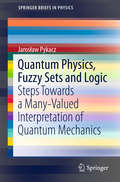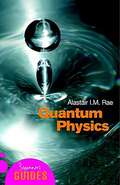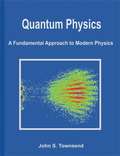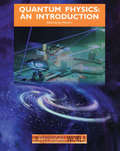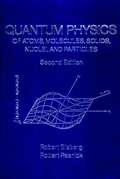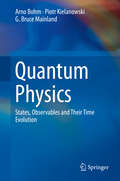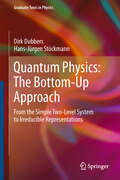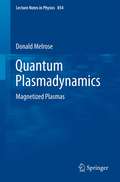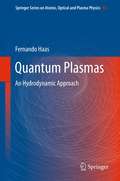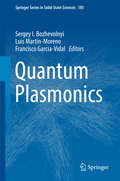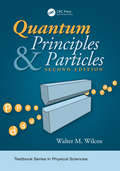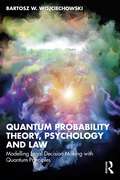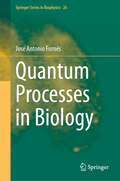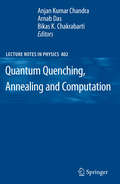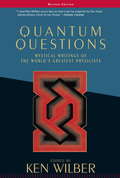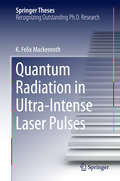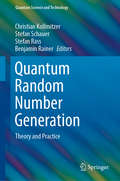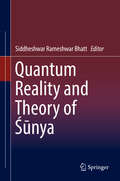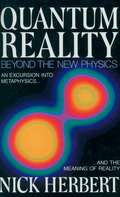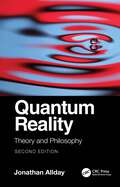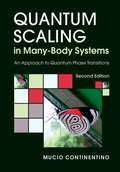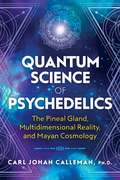- Table View
- List View
Quantum Physics, Fuzzy Sets and Logic
by Jarosław PykaczThis Brief presents steps towards elaborating a new interpretation of quantum mechanics based on a specific version of Łukasiewicz infinite-valued logic. It begins with a short survey of main interpretations of quantum mechanics already proposed, as well as various models of many-valued logics and previous attempts to apply them for the description of quantum phenomena. The prospective many-valued interpretation of quantum mechanics is soundly based on a theorem concerning the isomorphic representation of Birkhoff-von Neumann quantum logic in the form of a special Łukasiewicz infinite-valued logic endowed with partially defined conjunctions and disjunctions.
Quantum Physics, Mini Black Holes, and the Multiverse: Debunking Common Misconceptions In Theoretical Physics (Multiversal Journeys Ser.)
by John Terning Farzad Nekoogar Bill Poirier Yasunori Nomura"Modern physics is rife with provocative and fascinating ideas, from quantum mechanics to the multiverse. But as interesting as these concepts are, they are also easy to understand. This book, written with deft hands by true experts in the field, helps to illuminate some of the most important and game-changing ideas in physics today." Sean M. Carroll "The Multiversal book series is equally unique, providing book-length extensions of the lectures with enough additional depth for those who truly want to explore these fields, while also providing the kind of clarity that is appropriate for interested lay people to grasp the general principles involved. " Lawrence M. KraussThis book explores, explains and debunks some common misconceptions about quantumphysics, particle physics, space-time, and Multiverse cosmology. It seeks to separatescience from pseudoscience.The material is presented in layperson-friendly language, followed by additional technicalsections which explain basic equations and principles. This feature is very attractiveto non-expert readers who nevertheless seek a deeper understanding of the theories,and wish to explore beyond just the basic description.Multiversal Journeys™ is a trademark of Farzad Nekoogar and Multiversal Journeys, a501 (c) (3) nonprofit organization.
Quantum Physics: A Beginner's Guide (Beginner's Guides)
by Alastair RaeFrom quarks to computing, this fascinating introduction covers every element of the quantum world in clear and accessible language. Drawing on a wealth of expertise to explain just what a fascinating field quantum physics is, Rae points out that it is not simply a maze of technical jargon and philosophical ideas, but a reality which affects our daily lives.
Quantum Physics: A Fundamental Approach To Modern Physics
by John S. TownsendAn introduction to quantum mechanics and its applications with a truly innovative approach. From single-photon interference to the application of quantum mechanics to nuclear physics, Townsend's book provides a coherent picture of how the world works and how quantum mechanics can help to explain it.
Quantum Physics: An Introduction
by J MannersQuantum Physics: An Introduction guides you through the profound revolution in scientific thinking that overthrew classical physics in favor of quantum physics. The book discusses the basic ideas of quantum physics and explains its power in predicting the behavior of matter on the atomic scale, including the emission of light by atoms (spectra) and the operation of lasers. It also elucidates why the interpretation of quantum physics is still the subject of intense debate among scientists.
Quantum Physics: Of Atoms, Molecules, Solids, Nuclei, and Particles
by Robert Resnick; Robert EisbergA revision of a successful junior/senior level text, this introduction to elementary quantum mechanics clearly explains the properties of the most important quantum systems. Emphasizes the applications of theory, and contains new material on particle physics, electron-positron annihilation in solids and the Mossbauer effect. Includes new appendices on such topics as crystallography, Fourier Integral Description of a Wave Group, and Time-Independent Perturbation Theory.
Quantum Physics: States, Observables and Their Time Evolution (Texts And Monographs In Physics #348)
by Piotr Kielanowski Arno Bohm G. Bruce MainlandThis is an introductory graduate course on quantum mechanics, which is presented in its general form by stressing the operator approach. Representations of the algebra of the harmonic oscillator and of the algebra of angular momentum are determined in chapters 1 and 2 respectively. The algebra of angular momentum is enlarged by adding the position operator so that the algebra can be used to describe rigid and non-rigid rotating molecules. The combination of quantum physical systems using direct-product spaces is discussed in chapter 3. The theory is used to describe a vibrating rotator, and the theoretical predictions are then compared with data for a vibrating and rotating diatomic molecule. The formalism of first- and second-order non-degenerate perturbation theory and first-order degenerate perturbation theory are derived in chapter 4. Time development is described in chapter 5 using either the Schroedinger equation of motion or the Heisenberg’s one. An elementary mathematical tutorial forms a useful appendix for the readers who don’t have prior knowledge of the general mathematical structure of quantum mechanics.
Quantum Physics: The Bottom-Up Approach
by Dirk Dubbers Hans-Jürgen StöckmannThis concise tutorial provides the bachelor student and the practitioner with a short text on quantum physics that allows them to understand a wealth of quantum phenomena based on a compact, well readable, yet still concise and accurate description of nonrelativistic quantum theory. This "quadrature of the circle" is achieved by concentrating first on the simplest quantum system that still displays all basic features of quantum theory, namely, a system with only two quantized energy levels. For most readers it is very helpful to understand such simple systems before slowly proceeding to more demanding topics like particle entanglement, quantum chaos, or the use of irreducible tensors. This tutorial does not intend to replace the standard textbooks on quantum mechanics, but will help the average student to understand them, often for the first time.
Quantum Plasmadynamics
by Donald MelroseQuantum Plasmadynamics is a synthesis of the kinetic theory of plasmas and quantum electrodynamics (QED). In this volume, the approach applied to unmagnetized plasmas in volume 1 is generalized to magnetized plasmas. First, a covariant version of nonquantum kinetic theory is formulated for single-particle (emission and scattering) processes and the collective-medium response. The relativistic quantum treatment is based on solutions of Dirac's equation for an electron in a magnetostatic field, and single-particle processes are treated using a magnetized version of QED. The response of an electron gas is derived by generalizing the derivation of the response of the magnetized vacuum.
Quantum Plasmas
by Fernando HaasThis book provides an overview of the basic concepts and new methods in the emerging scientific area known as quantum plasmas. In the near future, quantum effects in plasmas will be unavoidable, particularly in high density scenarios such as those in the next-generation intense laser-solid density plasma experiment or in compact astrophysics objects. Currently, plasmas are in the forefront of many intriguing questions around the transition from microscopic to macroscopic modeling of charged particle systems. Quantum Plasmas: an Hydrodynamic Approach is devoted to the quantum hydrodynamic model paradigm, which, unlike straight quantum kinetic theory, is much more amenable to investigate the nonlinear realm of quantum plasmas. The reader will have a step-by-step construction of the quantum hydrodynamic method applied to plasmas. The book is intended for specialists in classical plasma physics interested in methods of quantum plasma theory, as well as scientists interested in common aspects of two major areas of knowledge: plasma and quantum theory. In these chapters, the quantum hydrodynamic model for plasmas, which has continuously evolved over the past decade, will be summarized to include both the development and applications of the method.
Quantum Plasmonics
by Sergey I. Bozhevolnyi Luis Martin-Moreno Francisco Garcia-VidalThis book presents the latest results of quantum properties of light in the nanostructured environment supporting surface plasmons, including waveguide quantum electrodynamics, quantum emitters, strong-coupling phenomena and lasing in plasmonic structures. Different approaches are described for controlling the emission and propagation of light with extreme light confinement and field enhancement provided by surface plasmons. Recent progress is reviewed in both experimental and theoretical investigations within quantum plasmonics, elucidating the fundamental physical phenomena involved and discussing the realization of quantum-controlled devices, including single-photon sources, transistors and ultra-compact circuitry at the nanoscale.
Quantum Potential: Physics, Geometry and Algebra
by Ignazio Licata Davide FiscalettiRecently the interest in Bohm realist interpretation of quantum mechanics has grown. The important advantage of this approach lies in the possibility to introduce non-locality ab initio, and not as an "unexpected host". In this book the authors give a detailed analysis of quantum potential, the non-locality term and its role in quantum cosmology and information. The different approaches to the quantum potential are analysed, starting from the original attempt to introduce a realism of particles trajectories (influenced by de Broglie's pilot wave) to the recent dynamic interpretation provided by Goldstein, Durr, Tumulka and Zanghì, and the geometrodynamic picture, with suggestion about quantum gravity. Finally we focus on the algebraic reading of Hiley and Birkbeck school, that analyse the meaning of the non-local structure of the world, bringing important consequences for the space, time and information concepts.
Quantum Principles and Particles, Second Edition (Textbook Series in Physical Sciences)
by Walter WilcoxThis textbook offers a unique introduction to quantum mechanics progressing gradually from elementary quantum mechanics to aspects of particle physics. It presents the microscopic world by analysis of the simplest possible quantum mechanical system (spin 1/2). A special feature is the author’s use of visual aids known as process diagrams, which show how amplitudes for quantum mechanical processes are computed. The second edition includes a new chapter and problems on time-dependent processes, in addition to new material on quantum computing and improved illustrations. Key Features: Provides a completely updated text with expanded contents. Includes a brand new chapter on time-dependent processes and expanded coverage of recent developments in particle physics. Emphasizes a visual approach employing process diagrams and utilizing new figures. Incorporates quantum information theory in a new appendix, with other helpful supplements on notation, lattice models, weak flavor mixing, and numerical simulations.
Quantum Probability Theory, Psychology and Law: Modelling Legal Decision Making with Quantum Principles
by Bartosz W. WojciechowskiThis book provides the first consideration of quantum principles in legal decision making. It shows how quantum probability theory can be applied to psychology and law to deepen our understanding of psychological and legal issues, suggesting a paradigm shift in the study of these areas. Written as an introduction to quantum probability theory for non-physicists, the book offers an accessible summary of how psychology can be applied to quantum phenomena for human decision making. It introduces psychologists and lawyers to fresh conceptual frameworks, including classical probability theory, classical statistics, data mining and quantum theory. Wojciechowski shows how quantum theory and concepts can be transferred to psychological research models, and can help to resolve previously unexplained psychological phenomena, influence scientific views, undermine traditional foundations of the legal system and result in the development of new research directions. Studies conducted by the author are used to show how problems facing legal decision making can be addressed in a completely new light with the application of quantum probability theory. This cutting-edge and innovative book will be of great interest to graduate students and researchers in the fields of forensic psychology and legal decision making, as well as legal professionals and legal scholars.
Quantum Processes in Biology (Springer Series in Biophysics #26)
by José Antonio FornésIn recent years, extensive research on stochastic processes such as neuron networks, molecular motors, dynamics models, anomalous diffusion, and disordered media has led to the development of various methods for applying the Classical and Quantum Smoluchowski Equation to these phenomena. This book focuses on presenting the solution to the Fokker-Planck equation using the Crank-Nicholson formalism. This method is particularly effective for handling systems with numerous interactions, requiring vector and matrix-oriented approaches suitable for implementation in Matlab. Among the topics treated in the book are: Dynamics of protons in DNA, Photosynthesis and the quantum mechanochemical model, Entanglement, coherence and decoherence, Excitons in the Fenna-Mathews-Olson complex, and Energy exchange between cells. The author has made an incredible work in facilitating the understanding of these complex topics. This book includes a brief and clear explanation of the Quantum theory and also includes code to build useful software to use in research environments. This volume is particularly helpful for graduate students in physics and biology interested in understanding biological processes with the use of quantum physics tools.
Quantum Processes, Systems, and Information
by Benjamin Schumacher Michael D. WestmorelandA new and exciting approach to the basics of quantum theory, this undergraduate textbook contains extensive discussions of conceptual puzzles and over 800 exercises and problems. Beginning with three elementary 'qubit' systems, the book develops the formalism of quantum theory, addresses questions of measurement and distinguishability, and explores the dynamics of quantum systems. In addition to the standard topics covered in other textbooks, it also covers communication and measurement, quantum entanglement, entropy and thermodynamics, and quantum information processing. This textbook gives a broad view of quantum theory by emphasizing dynamical evolution, and exploring conceptual and foundational issues. It focuses on contemporary topics, including measurement, time evolution, open systems, quantum entanglement, and the role of information.
Quantum Quenching, Annealing and Computation
by Bikas K. Chakrabarti Arnab Das Anjan Kumar ChandraThe process of realizing the ground state of some typical (frustrated) quantum many-body systems, starting from the 'disordered' or excited states, can formally be mapped onto the search of solutions for computationally hard problems. The dynamics through quantum critical points are especially crucial in the context of such computational optimization problems and have been investigated intensively in recent times. Several successful methods are now well-established, and this volume compiles a collection of introductory reviews on such developments and related aspects. Written by well known experts, these lectures concentrate on quantum phase transitions and their dynamics as the transition or critical points are crossed. Both the quenching and annealing dynamics are extensively covered. The style has been kept as tutorial as possible in order to make this volume a suitable reference for young researchers joining this exciting and burgeoning field of research.
Quantum Questions: Mystical Writings of the World's Great Physicists
by Ken WilberHere is a collection of writings that bridges the gap between science and religion. Quantum Questions collects the mystical writings of each of the major physicists involved in the discovery of quantum physics and relativity, including Albert Einstein, Werner Heisenberg, and Max Planck. The selections are written in nontechnical language and will be of interest to scientists and nonscientists alike.
Quantum Radiation in Ultra-Intense Laser Pulses
by K. Felix MackenrothScientific advances and several technical breakthroughs have led to a remarkable increase in available laser intensities over the past decades. In available ultra-intense laser fields, photon fluxes may become so high that free charge carriers interact coherently with several of the field's photons. In this thesis such nonlinear interactions are investigated for the prime example of radiation emission by electrons scattered from intense laser pulses of arbitrary temporal structure. To this end, nonlinear quantum field theory is employed taking the interaction with the laser into account exactly. After an in-depth introduction to classical particle dynamics as well as quantum field theory in nonlinearly intense laser fields the emission of one and two photons is explicitly analyzed. The results are then translated to viable technical applications, such as a scheme for the determination of the carrier-envelope phase of ultra-intense laser pulses and a proposal for detecting the strongly suppressed two-photon signal.
Quantum Random Number Generation: Theory and Practice (Quantum Science and Technology)
by Stefan Rass Stefan Schauer Christian Kollmitzer Benjamin RainerThis book provides an overview of state-of-the-art implementations of quantum random number generators (QRNGs), and especially examines their relation to classical statistical randomness models and numerical techniques for computing random numbers. The reader – who ideally has a background in classical statistics, computer science, or cryptography – is introduced to the world of quantum bits step by step, and explicit relations between QRNGs and their classical counterparts are identified along the way. Random number generation is a major pillar of cryptography. Capitalizing on the randomness inherent in quantum phenomena is a rapidly evolving branch of quantum cryptography with countless applications for the future. The value of quantum randomness for cryptographic purposes is empirically demonstrated in statistical evaluations of QRNGs’ performance compared to classical techniques for true and pseudorandom number generation. The book then provides an overview of technical implementations of QRNGs, before a concluding discussion of major achievements and remaining obstacles in the field rounds out the coverage, while also opening the door for future research directions.
Quantum Reality and Theory of Śūnya
by Siddheshwar Rameshwar BhattThe book deals with expounding the nature of Reality as it is understood in contemporary times in Quantum Physics. It also explains the classical Indian theory of Śūnya in its diverse facets. Thereafter it undertakes comparison between the two which is an area of great topical interest. It is a cross-disciplinary study by erudite Indian and western scholars between traditional Indian knowledge system and contemporary researches in Physical sciences. It points out how the theory of ‘Śūnyatā has many seminal ideas and theories in common with contemporary Quantum Physics. The learned authors have tried to dissolve the “mysteries” of Quantum Physics and resolved its “weird paradoxes” with the help of theory of Śūnyatā. The issue of non-separability or entanglement has been approached with the help of the Buddhist theory of Pratītyasamutpāda. The paradoxical situation of “wave-particle duality” has been explained with the help of Upaniṣadic theory of complementarity of the two opposites. The measurement problem represented by “Schrodinger’s cat” has been dealt with by resorting to two forms of the calculation of probabilities. Some writers have argued for Śūnyatā-like non-essentialist position to understand quantum reality. To make sense of quantum theory some papers provide a happy symbiosis of technical understanding and personal meditative experience by drawing multifarious parallels. This book will be of interest to philosophically inclined physicists and philosophers with interest in quantum mechanics.
Quantum Reality: Beyond the New Physics
by Nick HerbertThis clearly explained layman's introduction to quantum physics is an accessible excursion into metaphysics and the meaning of reality. Herbert exposes the quantum world and the scientific and philosophical controversy about its interpretation.From the Trade Paperback edition.
Quantum Reality: Theory and Philosophy
by Jonathan AlldayAs probably the most successful scientific theory ever created, quantum theory has profoundly changed our view of the world and extended the limits of our knowledge, impacting both the theoretical interpretation of a tremendous range of phenomena and the practical development of a host of technological breakthroughs. Yet for all its success, quantum theory remains utterly baffling. Quantum Reality: Theory and Philosophy, Second Edition cuts through much of the confusion to provide readers with an exploration of quantum theory that is as authoritatively comprehensive as it is intriguingly comprehensible. The book has been fully updated throughout to include the latest results in quantum entanglement, the theory and practical applications of quantum computing, quantum cosmology and quantum gravity. Needing little more than a school level physics and mathematics background, this volume requires only an interest in understanding how quantum theory came to be and the myriad ways it both explains how our universe functions and extends the reach of human knowledge. Written by well-known physics author and teacher Dr. Jonathan Allday, this highly engaging work: • Presents a thorough grounding in the theoretical machinery of quantum physics • Offers a whistle-stop tour through the early part of the 20th century when the founding fathers of quantum theory forever altered the frontiers of human thought • Provides an example-filled interpretation of the theory, its applications, and its pinnacle in quantum field theory (QFT), so crucial in shaping ideas about the nature of reality • Separates fact from speculation regarding quantum physics’ ability to provide a starting point for philosophical queries into ultimate understanding and the limits of science The world beneath the one that we experience with our senses is profoundly mysterious, and while we may never completely unravel that mystery, quantum theory allows us to come closer than ever to understanding where the science leaves off and the mystery begins. Quantum Reality: Theory and Philosophy, Second Edition makes that understanding accessible to anyone possessing a quest for knowledge and a sense of awe.
Quantum Scaling In Many-body Systems
by Mucio ContinentinoThis book on quantum phase transitions has been written by one of the pioneers in the application of scaling ideas to many-body systems OCo a new and exciting subject that has relevance to many areas of condensed matter and theoretical physics. One of the few books on the subject, it emphasizes strongly correlated electronic systems. Although dealing with complex problems in statistical mechanics, it does not lose sight of the experiments and the actual physical systems which motivate the theoretical work. The book starts by presenting the scaling theory of quantum critical phenomena. Critical exponents for different systems are calculated using both the momentum space and real space renormalization group approaches. The former is developed without the use of Feynman diagrams, allowing nonspecialists to fully appreciate the underlying physics of this method. The case of heavy fermions as an example of systems close to a zero temperature phase transition is presented and discussed in detail. This is also the case of non-Fermi liquid behavior associated with a quantum critical point. MetalOCoinsulator transitions are discussed within the scaling approach. The book ends with a discussion on first order quantum phase transitions, in particular those which occur due to a fluctuation-induced mechanism. Contents: Scaling Theory of Quantum Critical Phenomena; Landau and Gaussian Theories; Renormalization Group: The A-Expansion; Quantum Phase Transitions; Real Space Renormalization Group Approach; Heavy Fermions; A Microscopic Model for Heavy Fermions; MetalOCoInsulator Transitions; Density-Driven MetalOCoInsulator Transitions; Mott Transitions; The Nonlinear Sigma Model; Fluctuation-Induced Quantum Phase Transitions. Readership: Graduate students, lecturers and researchers in condensed matter physics. "
Quantum Science of Psychedelics: The Pineal Gland, Multidimensional Reality, and Mayan Cosmology
by Carl Johan CallemanA groundbreaking exploration of how psychedelics and quantum science are vital to understanding the evolution of consciousness and reality • Explains why altered states of consciousness exist, how they work, and why psychedelics have the effects that they do • Describes how quantum waves, rather than the DNA molecule, have been the driving force behind biological and historical evolution • Explains how psychedelics interact with the human mind to create altered states that may further the continued evolution of consciousness In this groundbreaking book, Carl Johan Calleman reveals the quantum science of the Maya, a science lost to the modern world that explains the phenomenology of psychedelics and altered states of consciousness. The ancient Maya had a sophisticated understanding of the multidimensional nature of reality and the forces that drive the evolution of consciousness. Calleman explains how quantum waves, illustrated by the Mayan Calendar, emanate from the center of the universe and activate new phases in the evolution of consciousness through holographic resonance, which alters the dualities of the human mind. For example, the 5th Wave, which dominated in Paleolithic times and evolved human consciousness above that of animals, brought a chaotic floating state reminiscent of the psychedelic or shamanic state, and the recent 8th Wave brought the digital revolution. The 9th Wave, which began in 2011, offers the potential for individual development of higher consciousness and healing if we can synchronize ourselves with its positive holograms. This multidimensional perspective explains why altered states of consciousness exist and how they work. Calleman describes the role of the pineal gland for the human mind, how it controls our state of consciousness and how it can connect us to the cosmic Tree of Life. He shows that the mind is a &“reducing valve&” that normally limits our experience of cosmic consciousness but that this can be reversed through altered states. As Calleman concludes, psychedelics like ayahuasca and DMT not only give rise to extraordinary mystical and cosmic experiences and enable access to healing states, but they also are important for harmoniously synchronizing humanity with the 9th Wave to further the evolution of consciousness.
